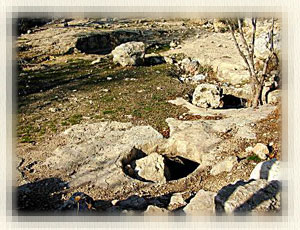 The Pool Of Gibeon The Pool Of Gibeon
“But when the inhabitants of Gibeon heard what Joshua did to Jericho and to AI, they worked craftily, and went, and pretended to be ambassadors. And they took old sacks on their donkeys, old wine skins torn and mended…” Joshua 9:3-4 “And Joab, the son of Zeruiah, and the servants of David, went out and meet them by the pool of Gibeon. So they sat down, one on one side of the pool, and the other on the other side of the pool.” 2 Samuel 2:13 “And each one grasped his opponent by the head and thrust his sword in his opponents side; so they fell down together. Therefore that place was called the Field of Sharp Swords, which is in Gibeon. So there was a very fierce battle that day…” 2 Samuel 2:16-17 In 1956, American excavations brought to light not only traces of the walls of the town of Gibeah, which is so frequently mentioned in the Bible, but also uncovered the scene of a bloody encounter in those days. Beneath the field of tomatoes in el-Jib, as the place is now called, Professor J.B. Pritchard of Columbia University discovered the Pool of Gibeon. He found a circular shaft, over thirty feet in diameter and thirty feet deep, driven vertically into bedrock. A spiral path led down a ramp cut into the inside wall. Below that a winding staircase, with two openings for light and air, descended for a further forty-five feet to the reservoir itself. When the rubble was cleared away, the great cistern began to fill slowly with water from the fissures in the rock as it had done three thousand years ago. “…that they feared greatly, because Gibeon was a great city, like one of the royal cities…” Joshua 10:2 Valuable evidence as to the celebrated wealth of the place was collected by the American scholars from the rubble of the vast cistern. It was now clear that Gibeon’s prosperity was a flourishing and well-organized wine trade. Sixty handles belonging to clay wine pitchers along with appropriate clay stoppers and fillers were stamped in ancient Hebrew characters with the firm’s trademarks. Among them were vintners with genuine Biblical names. Near the reservoir further diggings in 1959 and 1960 led to the discovery of extensive wine cellars. Sixty-six almost circular cavities about six feet deep and six feet in diameter had been carved out of the rock and sealed with round stone bungs. It was obvious that some of these cellars had been used as wine presses for trampling out grapes and others could be identified as fermentation vats. The total storage capacity so far discovered approaches 50,000 gallons. |